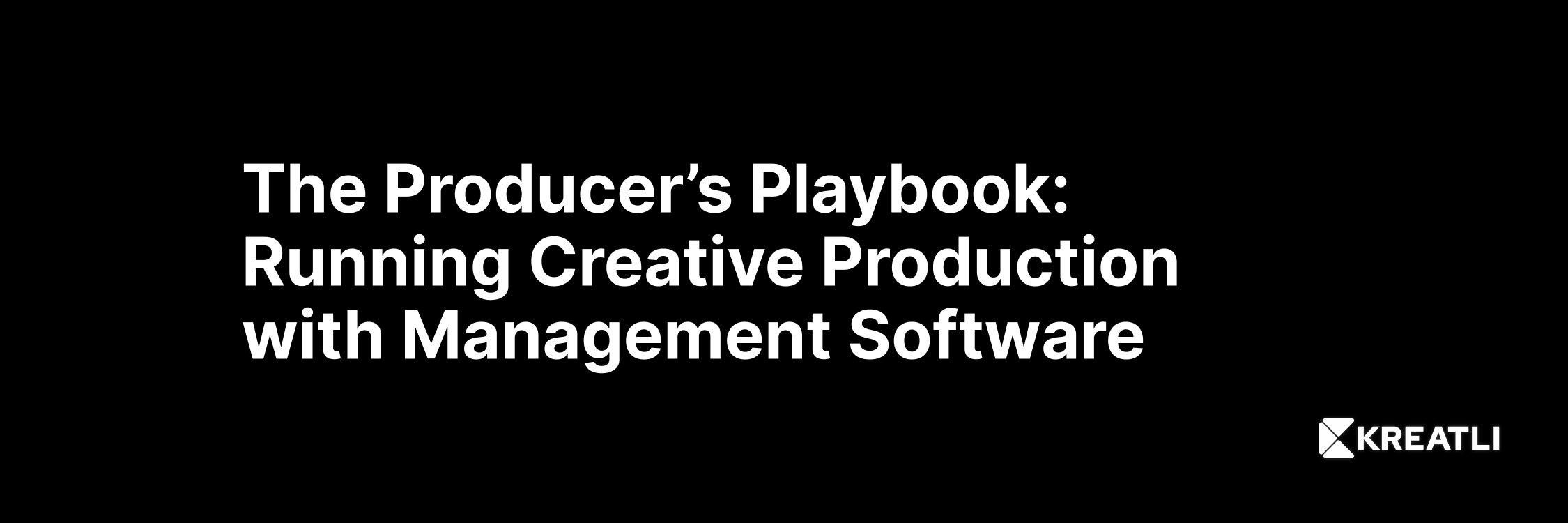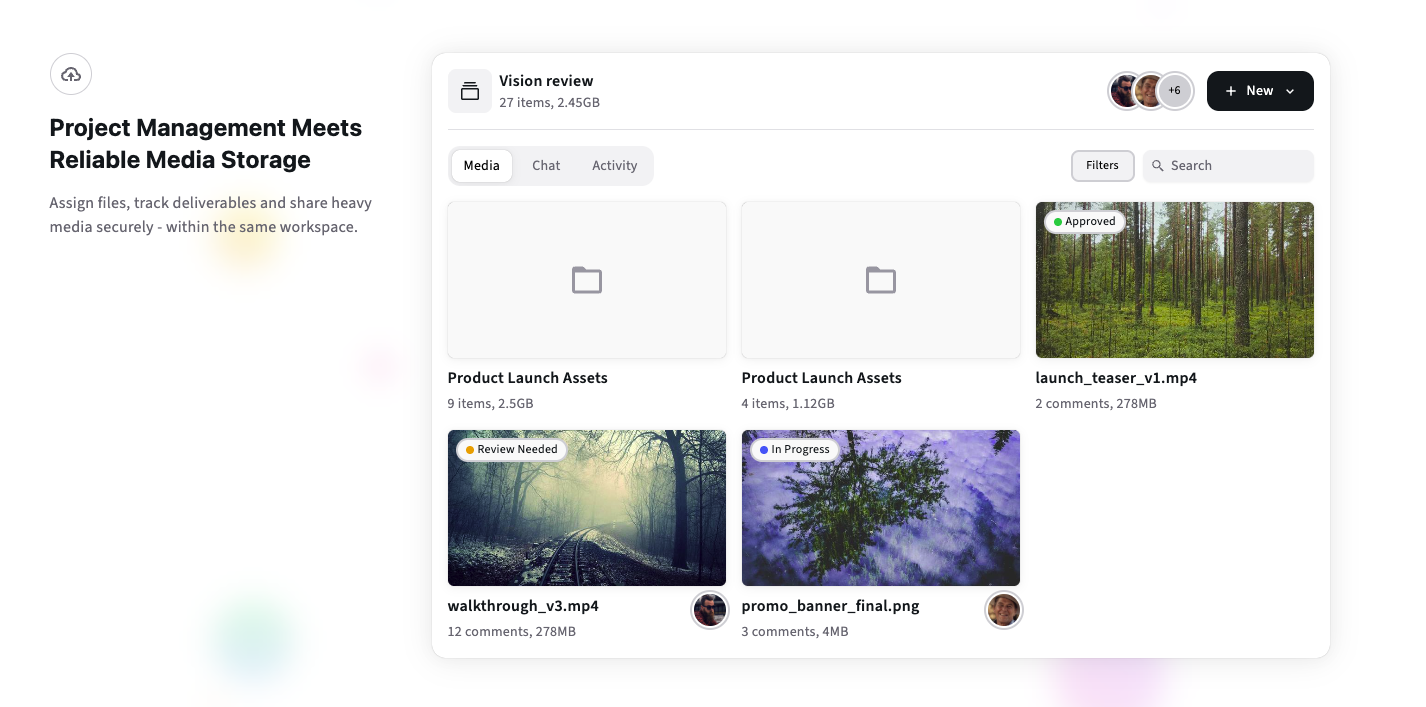The Producer’s Playbook: Running Creative Production with Management Software
A practical playbook for producers: briefs, templates, timelines, role checklists, and how to run projects inside a production management platform. Includes a 6-week pilot plan and reusable templates.

Why producers need a playbook, not just tools
Producing creative work is mostly coordination work. The bigger the team, the more moving parts, and the higher the risk of wasted time. Management software helps, but software without a playbook creates process clutter. This guide gives producers the exact, repeatable playbook to run briefs, reviews, and deliveries inside a production-ready system, so you spend less time chasing assets and more time shaping creative outcomes.
Throughout the article I show concrete templates, producer checklists, and a 6-week pilot plan you can run with your existing team and tools.
1. The producer’s job, distilled
A producer’s core outcomes are simple:
deliver the right creative, on time, on budget;
keep stakeholders aligned;
minimize rework.
Everything else is a mechanism to those outcomes: briefs that reduce guesswork, review processes that avoid ambiguity, and version control that prevents wasted edits.
A good playbook gives you standard inputs, predictable outputs, and a short feedback loop.
2. Required building blocks in your management software
Make sure your software supports these capabilities, they are the non-negotiables for production work:
Project-scoped workspaces - one place per project so files, comments, and approvals don’t leak across clients.
Proxy playback and timecode comments - reviewers must point to a frame, not write vague notes.
Versioning & approval gating - a visible approval button reduces ambiguity about final sign-off.
Permission templates - easy guest reviewer access, limited to the project.
Automations & webhooks - auto-generate proxies when a transfer completes, notify stakeholders on upload.
Searchable metadata and tags - quick findability saves hours.
If you want to test a project-first approach the fastest way, try a product like Kreatli, an end-to-end production management platform that bundles project workspaces, proxy review, and approval flows. Use it as the central place to run the playbook below.
3. The standard producer workflow, step by step
Below is the minimal, high-signal workflow to use on every brief. Keep it consistent across projects, so the team learns one cadence.
Brief intake - use a short intake form (see template below) that captures objective, audience, deliverables, assets, and hard deadlines. Save the brief in the project workspace.
Project kickoff - create the project workspace, invite core team and client as a guest reviewer, and attach the brief and asset list.
Ingest & proxy generation - ingest masters via your transfer tool, generate proxies, and link proxies to the project item. Automate this step when possible.
Rough cut + internal pass - editor publishes v01 to the project workspace for internal review with a focused checklist. Collect timecode-pinned comments only.
Client review rounds - share a branded review page with an explicit “What to review” checklist and a 48–72 hour review window. Use watermarked proxies for embargoed content.
Consolidate fixes - producer groups comments, assigns tickets to the editor, schedules a single edit pass.
Final approval & deliver - client clicks “Approve” inside the workspace, producer triggers a final master export and delivery via a transfer tool, then archives assets per retention policy.
Follow this pattern and you reduce unstructured feedback, and make approvals auditable.
4. Templates you should standardize now
Below are templates to paste into your software or CMS. Standardization reduces back-and-forth.
Brief intake form
Project name:
Objective: single sentence, measurable if possible (e.g., “Increase sign-ups by 10%”).
Deliverables: list formats, lengths, captions.
Audience & tone: 2–3 words.
Hard deadlines & embargo windows: dates and times.
Reference assets: links.
Reviewers & approval owner: name and email.
Budget & change order rules: simple numbers.
Review briefing snippet
What to focus on: (1) Story & pacing, (2) Audio levels, (3) Legal/branding.
How to comment: timecode-pinned comments only.
Deadline: YYYY-MM-DD, 23:59 local.
Approve if: no major changes, audio ok, copy correct.
5. Producer checklist - pre-launch and pre-delivery
Use this checklist as a producer’s daily ritual.
Pre-launch (before first edit):
Intake completed and attached.
Project workspace created, core team invited.
Ingested critical masters, proxies generated.
Permissions tested for guest reviewer.
Review brief attached to project.
Pre-delivery (before client review link goes live):
Proxy plays clean on mobile and desktop.
Watermarking applied if needed.
Review brief and checklist attached.
Client invited, onboarding email sent.
Export rules for final deliverables documented.
Post-approval:
Master delivered via transfer tool, receipt saved.
Project archived with metadata and approval proof.
Lessons learned note added to project template.
6. How to run clear review rounds
A few rules reduce iterations dramatically:
Limit review windows, 48–72 hours is a sweet spot.
Require timecode comments only, no freeform email notes.
Keep early rounds focused on high-level elements using trimmed reels.
Only one approval channel, the project workspace approval button.
Use a staging checklist and close the round at a scheduled time, then batch the edits.
These rules feel strict at first, teams adapt fast and reviews get faster.
7. Automation and integrations that remove toil
Automate the boring bits. Examples producers use every week:
Transfer webhook → proxy job → project item: When MASV or your transfer completes, a webhook triggers a cloud transcode, generates proxies, and attaches them to the project item.
NLE markers import: Export client comments as markers and import into Premiere or Resolve so editors land edits faster.
Approval webhook → delivery job: Customer approves final version, webhook triggers final master upload to the delivery bucket and sends a receipt email.
If you use a project-first system like Kreatli, an "end-to-end production management platform", look for built-in webhook or API support to wire these automations.
8. Measuring success - KPIs producers should track
Measure the right things, so you can improve the process.
Time-to-first-comment - how long between upload and first actionable comment. Shorter is better.
Average review rounds per deliverable - aim to reduce this by 30% over six months.
Time spent outside the NLE - how long editors pause to chase context. Reduce this with better notes in the project workspace.
Onboarding time for guest reviewers - target less than 15 minutes.
Delivery success rate - percent of deliveries completed without re-transfer or re-encode.
Track these per project and compare over time.
9. A 6-week pilot to embed the playbook
Run this pilot to prove the playbook and the software.
Week 0 - Prep
Pick 2 live projects, one small and one medium. Configure project templates, intake forms, and permission templates.
Week 1 - Ingest & automation
Hook transfer webhooks to proxy jobs, test automations. Verify proxies playable on mobile.
Week 2 - Internal review
Run internal review cycle, enforce timecode comments and the review checklist.
Week 3 - Client review round 1
Invite client, run a 48-hour review window. Collect and batch comments.
Week 4 - Resolve & v02
Batch edits, produce v02, test, and prepare final review.
Week 5 - Final approval & delivery
Get final approval in workspace, trigger delivery transfer, save receipts.
Week 6 - Retrospective & measure
Compare KPIs vs baseline, collect producer feedback, update templates.
If you want a fast place to run this, spin up a free project in Kreatli, the "end-to-end production management platform", and apply the pilot templates to two live briefs.
10. Common pitfalls and how to avoid them
Too many review channels - centralize comments in the project workspace, stop email cc loops.
Unclear ownership - always list an approval owner in the brief.
No automation for proxies - manual proxy generation causes delays, automate it.
Poor version naming - enforce a versioning convention like ProjectName_v01_editorInitial_date.
Ignoring client UX - test review links on the lowest bandwidth device your client uses.
Address these gaps proactively - producers who fix them once never regress.
FAQ
Q: How long should a typical client review window be?
A: 48–72 hours is a practical default. Shorter windows speed decisions, longer windows increase drift and lost context.
Q: Do producers have to be technical to run these automations?
A: No. Start with vendor-provided integrations and templates. Involve an engineer for webhook and custom automation once you validate the pilot.
Q: What if my clients refuse to use the review player?
A: Offer a simple option, a one-click download of the proxy with a short instruction. But insist on comments in the project workspace for traceability.
Conclusion
Production succeeds when repeatable processes meet reliable tools. Use the brief intake, the project workspace, proxy-based reviews, and strict review rules to reduce churn and speed approvals. Measure time-to-first-comment, review rounds, and onboarding time to track improvement. If you want to test the playbook quickly, start a free Kreatli project, and run the 6-week pilot above.
Can Kreatli become your Production Management Platform?
Book a 30-minute production audit and we will map the playbook to your toolchain and provide a downloadable producer checklist
